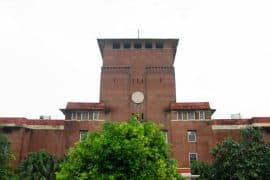One of the most famous tourist spots in the heart of North Kolkata, Kumartuli is a slum district dominated by the potters and sculptors of the city. Often online travel blogs are found to be romanticising the aesthetic offered by the place, but beyond all the artistic beauty lies a darker side to this place: caste-induced labour, immigrant struggle, and the economic divide.
Perched on the banks of the Hooghly River, Kumartuli has been a go-to destination for travel vloggers and art enthusiasts alike. In the narrow lanes, barely wide enough for a hand-pulled rickshaw to pass through, the only people you will usually meet are the Kumars, the idol-makers of the city. It is from here that idols of Goddess Durga and other deities make their way into Kolkata every year. Especially during the months preceding West Bengal’s biggest annual religious festival, Durga Puja, the old alleys of Kumartuli are thronged with customers ordering 13-foot-tall Durga idols for neighbourhood associations and residential pujas, as well as Instagram vloggers and art enthusiasts capturing the essence of Bengal’s artistic culture.
However, beyond the camouflage of this aesthetic beauty and the illusion of tradition, lies the tragic reality of the Kumartuli potters. A recent visit to the place revealed the unhealthy and unhygienic conditions in which the potters work. Streams of sewage running past idol-workshops, rotten food strewn across streets, naked children running through gullies, the makeshift idol workspace constructed out of plastic and bamboo, and the ‘kutcha’ residential huts of the workers that have fallen to rust with time paint an altogether different picture of the area. Despite working day and night—from shaping the idols with clay to painting and drying them—the workers are provided with a meagre income, sometimes not even enough to suffice for three days of meals.
The months preceding Durga Puja generally witness an influx of immigrant labour from other parts of Bengal, like Krishna Nagar, Nadia, Orissa, and Bihar. And so the rivalry between the old-established potters of Kumartuli and the temporary workers begins. According to research, 40 percent of the shops export less than 5 units of idols per year, while the rest sell more than 110 idols per year. The economic gap resides within the district as well. While some shops have an annual turnover of 15 lacs, there are others that make more than 60 lacs. However, no policies or renewal projects have been taken up by the government over the years to enhance the living conditions of the workers or provide them with better employment opportunities.
The oppressive conditions of the Kumartuli potters are intrinsically linked to their caste-induced status, which has often been deluded by the lens of culture and art of the ‘Bengal aesthetic’.
Most of the Kumars (or potters) you meet at Kumartuli are Bengali Hindu workers. Their occupation is decided by caste, as all the Kumars at Kumartuli share the same last name, ‘Pal’, belonging to the ceremonially pure Shudra caste. The homogenization of the area with people of a particular ethnicity can be credited to the British. The British East India Company, during the colonisation of Bengal following the Battle of Plassey in 1757, allotted “separate districts to the Company’s workmen”. These neighbourhoods in the heart of the Indian quarters acquired work-related names: Suriparah (the place of wine sellers), Collotollah (the place of oil men), Chuttarparah (the place of carpenters), Aheeritollah (cowherd’s quarters), Coomartolly or Kumartuli (potters’ quarters), and so on.
Looking at Kumartuli through a caste lens, can the poor living and working conditions be traced back to the caste-induced labour and oppression of the idol-makers? Is the economic divide between the potters’ quarter and the rest of urban Kolkata a direct result of caste division? Why has the government not taken enough measures to emancipate the conditions of these lower-caste workers? Is there ever a possibility for these sculptors to break through the ‘ceiling of caste’?
The answers to all these problems can be found only once the authorities and the people of Bengal start acknowledging the complex social dynamics involved in the subjugation of these workers rather than overshadowing them with the fanatical glamour and grandeur of ‘culture’. It’s high time that the illusion be broken.
Read Also: Of Remembrance and Letting Go: An Ode to Hometowns
Featured Image Credits: Google Images
Priyanka Mukherjee
[email protected]





Comments are closed.